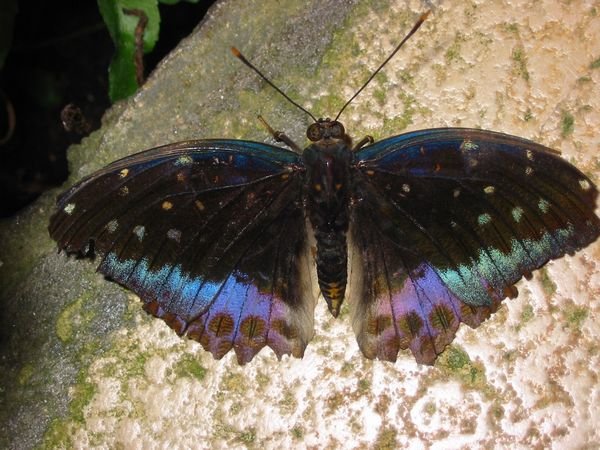Welcome to another post of my strange animals series where you get to meet some of the weirdest, coolest, and craziest animals on a daily basis!
If you are a close follower of mine, you might have noticed how I love posting about odd-looking caterpillars! Here's one I only found about yesterday. Definitely one of the weirdest out there, don't you think?
This bizarre caterpillar is scientifically described as Lexias pardalis. In everyday language it's known as the "common archduke".
Now, let's learn more about this amazing creature!
What's with the odd spines? Does it sting?
The branched spines that look like peacock feathers are probably the most characteristic trait of this caterpillar. Their main role is to help the animal camouflage on the upper surface of its host plant, C. pruriflorum.
The branched spines finish in colorful orange-and-black tips that will make you think twice before touching it.. Well, there is nothing to worry about! This animal is totally harmless and doesn't sting! Perhaps it's a form of aposematic mimicry (batesian mimicry) but I couldn't find a scientific source to confirm this. [3]

Archduke caterpillar (credit)
Where Can I Find One?
The species occurs in the Indomalaya ecozone, mainly in Singapore. Here's a map with some self-reported sightings of the butterfly stage if you want to try your luck:

L. pardalis sightings [2]
The main host of the species is the Cratoxylum cochinchinense plant, which grows naturally in the distribution area of L. Pardalis.
What does it evolve into?
Here are two pictures of the adult butterfly. The first is a male and the second a female:

Male specimen (credit)

Female specimen (credit)
As you can see, the species exhibits sexual dimorphism with very different pattern and colours for the two sexes.
The butterflies mainly feed on rotting fruits, especially in the genus Garcinia, but also on nectar from flowers. They are forest dwellers, avoding open and sunny areas and are usually found on shaded trails inside shrubs and other plants.
As a sidenote, it should be mentioned that there are two similar looking species that may be confused for L. Pardalis:
They are the Black-Tipped Archduke (Lexias dirtea merguia) which has males and females correspondingly similar to the Archduke, except that the antennae of the latter species is black instead of orange. The other species is the Yellow Archduke (Lexias canescens pardalina) in which both the sexes resemble the female of the Archduke, but are smaller in size. All three prefer shaded habitats in the forest understorey in the nature reserves of Singapore. [3]
Common archduke butterflies are rather large and fast flying, with a wingspan of approximately 8 to 9 cm. Females are slightly larger.
Lifecycle
Here's a quick breakthrough of the species' life-cycle:
- Their life begins as a tiny, green, dome-shaped egg, laid singly on the underside of a leaf of the host plants. After day 2, the eggs starts to take a purplish brown color.
- 4 days later, the egg hatches and the 1st instar caterpillar emerges
- It takes approximately 15 days for the caterpillar to reach the fifth and final instar, which lasts approximately 9 days. By then, the caterpillar has a mature length of about 5 cm.
- In its last day as a caterpillar, the creature seeks out a spot on the midrib on the underside of a mature leaf and stays there. There it begins the pupation process
- 10 days later a new butterfly emerges from the cocoon
Below are some videos showing some of the stages of the caterpillar's life-cycle. I also suggest you to read this beautifully illustrated post, if you want to experience the entire process from start to finish.
An Archduke cat Inflating its spines after shedding its first instar skin
The moult of an Archduke caterpillar to 4th instar, part (two parts)
Pupation event of an Archduke caterpillar
Is the species threatened?
No, the species appears to do fine and well, without any major threats at the moment :)
The End
I really hope you were amazed as much as I was by this beautiful creature! See you tomorrow, in my next strange animals post!
References & Further Reading
- https://en.wikipedia.org/wiki/Lexias_pardalis
- http://www.inaturalist.org/taxa/130335-Lexias-pardalis
- http://butterflycircle.blogspot.gr/2009/09/butterfly-of-month-september-2009.html
- http://butterflycircle.blogspot.gr/2010/02/life-history-of-archduke.html
- Funet.fi/pub/sci/bio/life/insecta/lepidoptera/ditrysia/papilionoidea/nymphalidae/limenitidinae/lexias/

My dear readers, thank you for reading today's article. Hopefully, you found it interesting enough to follow me, @trumpman. You may also want to check my strange animal series where you get to discover some of the world's weirdest animals! Here are the last 5 weirdos of the series:
- Pariphiculus stellatus: New Weird Crab Species Discovered In Taiwan
- Yellow Boxed Fish: Is This the Cutest Fish or What?
- BigFin Squid: Creepy, Alien-Like Terror From the Deep
- 9 Incredibly Weird Animal Penises !!!
- Beauty Stings #2 - The Wattle Cup Caterpillar
- Leptodirus hochenwartii: The First Cave-Dwelling Animal Ever Discovered
Steemstem & Steemiteducation
Interested in science? Please, don't forget to check the @steemstem, a community-driven project meant to promote well-written, high-quality, STEM-related content (STEM as for Science, Technology, Engineering and Mathematics). Just click here to join us! Also a big thank you goes to the @steemiteducation project for liking and sharing my content. Check em out, they have some cool stuff :)
Greek Community
A final big thanks goes to all my fellow greeks who support me with their love! You guys rock! A special mention also goes to @rouketas and @skapaneas for bringing us all together and @ruth-girl for making me the avatar below!






